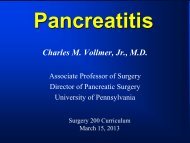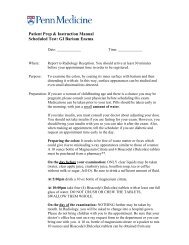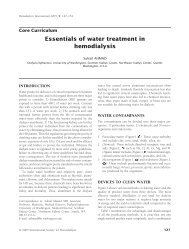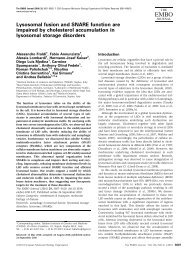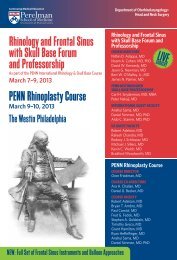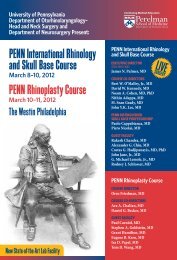Chairman's Note - Penn Medicine - University of Pennsylvania
Chairman's Note - Penn Medicine - University of Pennsylvania
Chairman's Note - Penn Medicine - University of Pennsylvania
You also want an ePaper? Increase the reach of your titles
YUMPU automatically turns print PDFs into web optimized ePapers that Google loves.
OtOrhinOlaryngOlOgy - head and neck Surgery at the univerSity Of <strong>Penn</strong>Sylvania<br />
Research Roundup<br />
Early Sensory Changes in Patients<br />
with Neurodegenerative Diseases<br />
Researchers have<br />
long suspected that<br />
environmental<br />
agents, including<br />
toxins and viruses,<br />
may be catalysts for<br />
a number <strong>of</strong><br />
neurodegenerative<br />
Richard L. Doty, PhD<br />
diseases, including<br />
Alzheimer’s disease<br />
and Parkinson’s disease. Pr<strong>of</strong>essor Richard<br />
L. Doty, PhD, <strong>of</strong> <strong>Penn</strong>’s Department <strong>of</strong><br />
Otorhinolaryngology –Head and Neck<br />
Surgery, a renowned expert in the olfactory<br />
system, is exploring the possibility that<br />
some cases <strong>of</strong> neurodegenerative disease<br />
may be initiated or catalyzed by<br />
environmental agents that enter the brain<br />
via the olfactory pathways. Recently he and<br />
his colleagues have shown that young<br />
individuals exposed to high levels <strong>of</strong><br />
pollution in Mexico City exhibit olfactory<br />
dysfunction and evidence, at autopsy, the<br />
pathology <strong>of</strong> Alzheimer’s disease in their<br />
olfactory bulbs.<br />
4 WWW.uPhS.u<strong>Penn</strong>.edu/<strong>Penn</strong>Orl<br />
In 1968, Dr. Doty received his MA degree<br />
from California State <strong>University</strong>, San Jose, in<br />
conjunction with the National Aeronautics<br />
and Space Administration (NASA), where<br />
he studied the vestibular system <strong>of</strong> humans.<br />
He obtained his PhD degree in<br />
Comparative Psychology from Michigan<br />
State <strong>University</strong> in 1973, specializing in<br />
olfaction. He subsequently completed a<br />
postdoctoral fellowship in Behavioral<br />
Endocrinology at the <strong>University</strong> <strong>of</strong><br />
California, Berkeley. Presently he is the<br />
Director <strong>of</strong> the <strong>University</strong> <strong>of</strong> <strong>Penn</strong>sylvania’s<br />
Smell and Taste Center, which he c<strong>of</strong>ounded<br />
in 1980. He is perhaps best known<br />
for developing the <strong>University</strong> <strong>of</strong><br />
<strong>Penn</strong>sylvania Smell Identification Test<br />
(UPSIT), the most widely used quantitative<br />
test <strong>of</strong> olfactory function in the world. This<br />
test has been heralded as the “eye chart <strong>of</strong><br />
the nose” and has been translated into over<br />
a dozen foreign languages. Dr. Doty, who<br />
has published more than 350 scientific<br />
articles, chapters, and books on taste and<br />
smell, was the 2005 recipient <strong>of</strong> the<br />
Association for Chemoreception Science’s<br />
Max Mozell Award for Outstanding<br />
Achievement in the Chemical Senses, the<br />
highest honor that can be bestowed by the<br />
peers <strong>of</strong> his pr<strong>of</strong>ession.<br />
As a result <strong>of</strong> funding from the Department<br />
<strong>of</strong> Defense, Dr. Doty and his team are<br />
currently examining sensory changes that<br />
occur in the earliest stages <strong>of</strong> Parkinson’s<br />
disease. Extensive behavioral and<br />
electrophysiological assessment <strong>of</strong> all the<br />
major senses is being made before and after<br />
dopamine therapy. These results are being<br />
compared to those from SPECT imaging <strong>of</strong><br />
the dopamine transporter within the<br />
nigrostrial region <strong>of</strong> the brain, the brain<br />
region where the motor symptoms <strong>of</strong> this<br />
disease arise. His research is important not<br />
only for better defining the non-motor<br />
elements <strong>of</strong> this disease, but for<br />
understanding their dependence upon<br />
dopamine dysfunction, their relationship to<br />
one another, and whether some<br />
combination <strong>of</strong> sensory measures may<br />
ultimately be useful in identifying people at<br />
risk for the disorder. In the future, such<br />
detection may allow for early therapeutic<br />
intervention before irreversible neural<br />
degeneration has occurred.<br />
Dr. Doty notes, “Before the development<br />
<strong>of</strong> the UPSIT, the influences <strong>of</strong> a wide<br />
range <strong>of</strong> diseases on the ability to smell<br />
were unknown. As a result <strong>of</strong> this single<br />
development, we now know that a number<br />
<strong>of</strong> neurological disorders are heralded by<br />
olfactory dysfunction. A key question is<br />
whether such dysfunction aids in<br />
understanding the etiology <strong>of</strong> such<br />
disorders, a question that is currently<br />
being addressed in laboratories<br />
throughout the world.”



